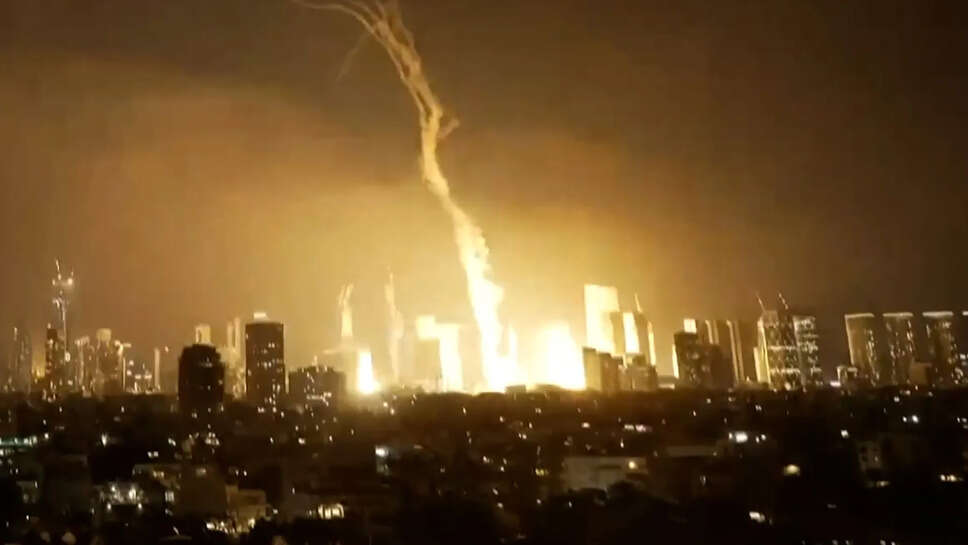Airstrikes, Missiles, Chaos: Israel and Iran Exchange Heavy Fire

In a dramatic turn of events, the long-simmering conflict between Israel and Iran exploded into full view with a series of overnight airstrikes, missile launches, and escalating rhetoric that has put the entire Middle East—and much of the international community—on high alert. The sheer scale of the exchanges between the two rival powers marks a dangerous new chapter in a decades-old geopolitical rivalry.
A Night of Fire and Fury
In the early hours of the morning, air raid sirens echoed across multiple cities in both Israel and Iran. What began as isolated reports of explosions quickly escalated into a confirmation of large-scale military engagement. Multiple Iranian sites—reportedly including air defense systems, military bases, and suspected nuclear facilities—were struck by Israeli air power in what appears to be a coordinated, strategic operation.
Israel, in its response, claims the strikes were pre-emptive and necessary in the face of growing threats from Iran’s expanding missile program and alleged plans for a nuclear weapons capability. The Israeli military reportedly deployed dozens of fighter jets, drones, and long-range precision missiles in the operation.
Within hours, Iranian forces retaliated by launching their own barrage of ballistic missiles and unmanned drones targeting military and civilian infrastructure in Israeli cities. Loud explosions were heard across parts of central Israel, including Tel Aviv and Haifa, triggering panic among residents and prompting the activation of the country’s missile defense systems.
Casualties and Damage
Though exact figures remain unconfirmed, initial reports suggest that both sides have suffered casualties and infrastructure damage. In Iran, several high-value military sites were reportedly hit, causing explosions and fires. Among the targets were rumored underground bunkers, radar installations, and facilities tied to Iran’s ballistic missile program.
On the Israeli side, emergency services responded to several locations affected by falling debris and intercepted missile fragments. While Israel’s Iron Dome defense system reportedly intercepted a majority of the incoming projectiles, some did manage to hit their targets. Civilian injuries have been reported, along with property damage in areas close to the impact zones.
Hospitals in both nations were put on high alert, with several cities declaring states of emergency. Authorities have urged citizens to remain indoors and avoid large gatherings.
A Brewing Conflict Decades in the Making
This overnight exchange is not an isolated incident, but rather a culmination of years of hostilities between the two nations. Israel views Iran as an existential threat, particularly due to its support of militant proxy groups such as Hezbollah in Lebanon and various militias in Syria and Iraq. Iran, on the other hand, perceives Israel as a destabilizing force in the region and accuses it of assassinating scientists and sabotaging its infrastructure through covert operations.
For years, these tensions have simmered beneath the surface, punctuated by cyberattacks, drone strikes, and indirect confrontations. However, the latest exchange marks a rare instance of direct military conflict between the two powers.
Regional Fallout
The consequences of this escalation are already rippling across the Middle East. Neighboring countries have begun reinforcing their borders and issuing travel advisories. Several international airlines have rerouted flights to avoid the airspace over both Israel and Iran. Crude oil prices spiked overnight, a clear reflection of fears that the conflict could spiral into a broader regional war.
In Lebanon, the Iran-backed Hezbollah movement has raised its alert level, while other Iranian-aligned groups in Syria and Iraq have threatened to join the fight if hostilities continue. Israel, for its part, has placed its northern borders on heightened military readiness and evacuated some civilian populations near potential flashpoints.
Gulf nations, many of which have developed closer ties to Israel in recent years, find themselves in a precarious position. While aligned in their opposition to Iranian influence, they remain wary of being drawn into direct confrontation.
Global Reactions
World leaders have issued calls for calm, urging both Israel and Iran to exercise restraint. Emergency sessions are being convened by diplomatic bodies to assess the situation and determine a path forward. Though there is a universal call for de-escalation, the path to peace remains unclear.
Many analysts believe that the strikes may derail any remaining efforts at diplomatic negotiations surrounding Iran’s nuclear program. Any progress made toward renewed agreements or inspections may now be frozen indefinitely.
What Led to This Escalation?
While both nations have long traded accusations and threats, recent weeks saw a sharp uptick in provocations. Reports of Iranian missile shipments to proxy groups, Israeli reconnaissance missions, and heightened rhetoric from both governments created an environment ripe for conflict.
Some speculate that internal political pressures may have played a role. In both countries, leaders are facing domestic challenges—economic, political, and societal—and external conflict has historically served as a tool for national unity and distraction.
The Military Dimension
Israel’s military doctrine has long centered around swift, overwhelming strikes designed to neutralize threats before they can materialize. Its intelligence and surveillance capabilities allow for pinpoint targeting, often well beyond its borders.
Iran, on the other hand, has invested heavily in asymmetric warfare, relying on ballistic missiles, drones, and regional militias to extend its influence. While it lacks the air superiority of Israel, it compensates with range and volume, a strategy evident in last night’s missile salvo.
Both nations are now likely evaluating the next steps. Should the confrontation escalate further, it could move from a tit-for-tat exchange to a prolonged conflict involving land, sea, air, and cyber domains.
The Risk of All-Out War
The primary fear among regional observers is that this latest exchange could tip the balance toward an open war. With multiple flashpoints across Lebanon, Syria, and Iraq already active, a full-scale conflict between Israel and Iran could ignite a regional firestorm involving multiple countries and non-state actors.
Civilian populations in both countries are bracing for more attacks. Shelters have been opened, and cities are reinforcing emergency protocols. Meanwhile, both militaries are mobilizing reserves and moving equipment to forward positions.
A Dangerous New Era
The overnight airstrikes and retaliatory missile attacks mark one of the most dangerous escalations in the Israel–Iran rivalry. What happens next will likely shape the Middle East for years to come. The possibility of diplomacy seems remote, and the appetite for conflict appears stronger than ever.
In the absence of immediate de-escalation, the world now watches nervously as two powerful, ideologically opposed nations stand on the brink of what could become a prolonged and devastating war.
